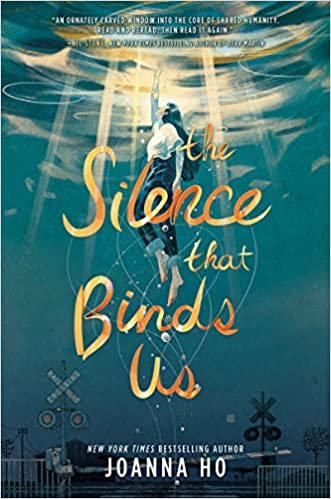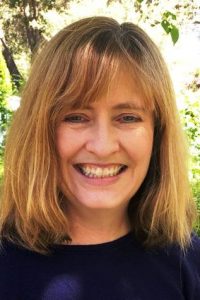interview by Kristi Wright
Joanna Ho and I met through our local SCBWI chapter and I’ve always been in awe of her thoughtful, courageous commitment to social justice. Since then, she’s become a literary force, with three exquisite award-winning picture books, two of which have been New York Times best-sellers, and now an extraordinary YA debut, The Silence that Binds Us, that tells the story of Maybelline Chen and her family in the aftermath of her beloved brother Danny’s death by suicide.
KidLit Craft: We know from previous interviews (and in your author note) that your inspiration for The Silence that Binds Us was both a desire to tell a story about anti-Asian racism and the teenage suicide epidemics that previously racked the Palo Alto community. With that said, when it came to putting words on the page, where did you start? Theme, character, setting, plot, etc?
Joanna Ho: I really started with theme – the ideas I wanted to explore through the story. I wanted to write a story about Anti-Asian racism and its many insidious forms, speaking out and solidarity. While there are many ways I’ve experienced racism throughout my life, when I began to think of times this racism took on a public face, I immediately thought of the suicide clusters and the continuing overt racism against Asians in my supposedly liberal community. From there, the setting fell into place; Sequoia Park is based very much on the Bay Area community where I went to high school. I did a lot of work interviewing sibling suicide survivors and mental health professionals before I started writing the book. I needed their help to get to know my characters and their journeys, and I wanted to make sure I made every effort to tell the story in a way that would capture truth without being too triggering or sensational. I worked through key plot points in my head before trying to put things on paper and really got to know my characters as I wrote and revised each draft of the manuscript.
KLC: Your book addresses so many different nuances when it comes to racism and the human condition, and yet it does so organically via Maybelline’s character-driven journey. How did you manage all these swirling intersectional issues? Did you have any craft techniques for not being overwhelmed?
JH: Life is intersectional. It is for adults. It is for kids. It is for teens, who are aware and navigating so many personal and systemic pushes and pulls every day. It’s overwhelming and writing about it is overwhelming also! When I first started out, I wanted to avoid a lot of the school scenes, the mental health and social aspects of the story. I knew it would be such a heavy lift and I was hiding from it! It became really obvious pretty quickly that I was trying to write my way around the hard things and the story didn’t work. I learned that I can’t avoid writing things because they’re hard. I had to take the time to learn – talk to more experts, do more research, then really dive into my characters to see how things played out. Also, the layers and complexity didn’t come through in my first draft, or my second or third drafts either! My editor – who is brilliant – could see what I was trying to do and where I hadn’t quite accomplished my vision yet. It is through many many stages of revisions that I was able to better understand and shape characters and explore intersectional issues.
KLC: You use a variety of narrative methods: poetry, prose, texting, short chapters, novel-in-verse. Can you speak to the craft of picking various methods to tell your story? Did you find that certain methods were more expressive of a particular emotion, for instance?
JH: I did not plan in advance to use these different narrative methods throughout the story. They each came naturally as I drafted. The texting began because I wanted a way to show the friendship between May, the protagonist, and her best friend, Tiya. Texting or messaging is so prevalent in teen (and adult!) communication and it also gave me a way to show different aspects of May’s personality that didn’t come through in the direct storyline. May’s poetic verses were a way to differentiate the story from her writing; I love that poetry packs layers of meaning and power into a small number of words. I think my picture book writing background and style played a large role in May’s forms of expression! The short chapters mirrored May’s experience of grief; small bursts of the things that stood out to her in the seemingly unending darkness of her heartbreak. Hopefully, they allowed the reader to experience the journey along with May.
KLC: Your story is both universal and specific. Do you have any suggestions for other writers for how to tap into their own truths while also making space for people to find commonality?
JH: The more specific a story, the more universal it becomes. This is one of the most enduring bits of writing advice I have ever received. When we can write to one particular story, experience, character with specific detail and nuance, it makes it real. It feels true. There are always spaces to find our shared humanity, and this is only possible when we come to understand the richness around us.
KLC: Your characters are so three-dimensional. Can you share any techniques you used to present that humanity on the page?
JH: A billion rounds of revision and a brilliant editor! Though I did character interviews and character sheets before I began writing The Silence That Binds Us, I came to know my characters as I wrote each draft. May sounded like two different people in the final chapters of the first draft and compared to the early chapters. I came to understand her voice and motivations more clearly just by writing the story. I completely rewrote some characters and changed some storylines after I received editorial feedback. For example, Ava Prince was a stereotypical mean girl in my early drafts. You’ll have to read the book to know how she turned out! Each round of revision gave me a new opportunity to add depth and nuance to each character and the story.
KLC: The Silence that Binds Us deals with some of the hardest topics imaginable and yet it finds joy as well. Do you have any thoughts on craft and how a writer can balance the sorrow and joy in their work?
JH: It is possible to feel joy, to laugh, even when we are experiencing great darkness. It is part of our shared human experience. Sometimes this is in extremes – my first book, Eyes that Kiss in the Corners, was published and debuted on the NYT Bestseller list in the middle of the pandemic when I was navigating a protracted divorce while trying to lead a high school in distance learning. Sometimes this is all in a matter of minutes – my daughter will sob in my arms and use her hands to show me her heart is broken, then laugh hysterically with her brother while they play goofy games around the house. Recognizing our own moments of joy in the midst of struggle is one way we can recognize those possibilities in our characters’ lives and journeys too.
KLC: How has being published changed your writing practice/writing process?
JH: I am much more trusting of the process and much more forgiving of my first drafts. I really despise writing them! I used to feel so frustrated and dejected that they did not in any conceivable way, shape, or form mirror the idea in my head. I felt embarrassed to show them to others. Now I know first drafts are trash and that’s okay! I just need to get my ideas out on paper and not worry too much about the writing or anything else. Once it’s on the paper, I can play.
KLC: What do you feel you’ve gained from being a part of the KidLit community?
JH: This community has been incredibly supportive. I don’t think I have enough space to gush on this topic! I have found that the community of kidlit writers who are also passionate about equity and justice are some of the most brilliant, warm and inspiring people I know. They write their hearts into their stories, they amplify each other, put themselves out there to create needed change and I learn so much from their words, organizing and outreach. I am incredibly grateful to be part of this community.
KLC: What can Joanna Ho fans look forward to next?
JH: Lots of picture books! (KidLit Craft note: Already published picture books: Eyes that Kiss in the Corners, Eyes that Speak to the Stars, and Playing at the Border: a story of Yo-Yo Ma.)
Out in 2023:
ONE DAY, illustrated by Faith Pray
SAY MY NAME, illustrated by Khoa Le
THE WAVE RIDERS, illustrated by Cátia Chien
Out in 2024:
EYES THAT WEAVE THE WORLD’S WONDERS, illustrated by Dung Ho
WE WHO PRODUCE PEARLS, illustrated by Amanda Phingbodhipakkiya
For more YA author interviews, check out this Q&A with Misa Sugiura and this one with Stacey Lee.

Joanna Ho is the New York Times bestselling and award-winning author of many books for kids. She has received the Golden Kite Award, an Ezra Jack Keats Honor, and a Golden Poppy Award.
She is a writer and educator with a passion for anti-bias, anti-racism and equity work. She holds a BA in psychology from the University of Pennsylvania, and a master’s from the Principal Leadership Institute at Berkeley. She has been an English teacher, a dean, the designer of an alternative-to-prison program, a creator of educator professional development, and a high school vice principal.
She lives in the Bay Area, where she survives on homemade chocolate chip cookies, outdoor adventures, and dance parties with her kids. Keep your eyes open for more books to come!
Kristi Wright (co-editor) writes picture books and middle grade novels. Her goal as a writer is to give children a sense of wonder, a hopefulness about humanity, and a belief in their future. She is represented by Kurestin Armada at Root Literary. She is an active volunteer for SCBWI and a 12 X 12 member. Find her at www.kristiwrightauthor.com and on Twitter @KristiWrite.





COMMENTs:
0